Regional Tourism Ecosystem as a Tool for Sustainable Development during the Economic Crisis
Abstract
1. Introduction
2. Sustainable Tourism and Digital Ecosystem Concepts
2.1. Methodology of a Concept for Sustainable Tourism Development
- (1)
- economic viability, defined as a guarantee of the sustainability and competitiveness of tourism destinations and businesses so that they can maintain their wealth and guarantee their long-term benefits;
- (2)
- local prosperity, which means maximising the contribution of tourism to the prosperity of destinations, including maintaining the proper balance of the tourist load in the region;
- (3)
- quality of employment, understood as an increase in the number of local tourism-related job offers, including the level of wages, conditions of service, and accessibility, without favouring any group over another regardless of their gender, race, physical disabilities, or other factors;
- (4)
- affordable tourism, which means providing safe and comfortable travel experience to all visitors regardless of gender, race, or physical disabilities [19].
- assuring consistent revenue in the tourism sphere in general and each individual tourism-related business in particular (Phillips., Faulkner, Ashley, De Brine (2022)) [31];
- ensuring employment of the population in the tourism sector, which means ensuring a reliable level of social development (Malatest, MacFeely (2014)) [32];
- institutional level of ensuring sustainable development in the tourism sector, which implies the development of a regulatory framework, control over the expenditures, mainly over the state funds designated for infrastructure projects in this area, and combating bribery and corruption (Gallego, Rosselló-Nadal, Fourie, Tarlow (2022)) [33];
- ensuring innovative development and the inflow of investments into the industry (Nordin, Novella et al., (2006)) [34].
2.2. Methodology of Digital Ecosystem Concept Development
- -
- business ecosystems that are built around a single company and its business environment, which represents a network of interconnected economic players (both humans and legal organisations) that influence the key company’s operations directly or indirectly;
- -
- ecosystems that are established around a key innovative technology or innovative product, as well as the production of complementary goods, works, and services;
- -
- digital ecosystems, which are built on digital platforms and combine the primary business with several related businesses that provide related goods and services, are valued more by customers due to their digital interactions. Related businesses that operate within the framework of digital ecosystems have the chance to produce better innovations through network interactions and joint projects [47]. According to Chang and West (2006) [48], business ecosystems in the digital environment and biological ecosystems in the natural environment feature common characteristics. The authors claim that full-fledged digital ecosystems are characterised by such features as: connectivity and interaction of ecosystem participants; self-regulation in order to maintain internal balance; complex structure of interactions; and clustering of participants.
3. Research Results
3.1. Analysis of the Sustainable Development Level in Russian Regions
- (1)
- selection of mechanisms for sustainable tourism development and determination of their weight values based on independent expert evaluations using the Delphi method;
- (2)
- identification of quantitative and qualitative indicators describing the chosen strategies for the development of sustainable tourism in the region;
- (3)
- calculation of indicators characterising the mechanisms of sustainable tourism development for each region (Figure 1);
- (4)
- computation of integral indicators describing the development processes in regional tourism (Figure 2). The integral indicator is computed based on the previously acquired data on tourism potential in the region (Appendix A);
- (5)
- ranking of regions based on the values of integral indicators: the higher the value of the integral indicator, the higher the position of the region in the ranking. For an overall evaluation of the sustainable development of tourism in the regions, it is necessary not only to conduct a thorough evaluation of tourism and recreational potential while taking into account the level of expertise of regional tourist offices, but also to establish the level of sustainable tourism development based on the analysis of the identified mechanisms and presented in the form of a ranking. A matrix analysis is suggested as a basis for such an evaluation, allowing comparison of the diverse tourist and recreational potential and ranking of regions according to the degree of sustainable tourism development.
3.2. Prospects of Tourism Development in Russian Regions
3.3. Research on the Development of Digital Ecosystems in Russian Regions
4. Discussion
5. Conclusions
Author Contributions
Funding
Institutional Review Board Statement
Informed Consent Statement
Data Availability Statement
Acknowledgments
Conflicts of Interest
Appendix A
| Environmental Index Indicators | |
|---|---|
| Atmosphere, air | This indicator shows how polluted the air is in the regions of the Russian Federation. The evaluation is based on the ISA index of atmospheric pollution, which considers both the danger class of contaminants and the volume indicators of pollution. This indicator additionally takes into account urgent circumstances involving pollution emissions as well as the modernisation of gas treatment facilities. |
| Water resources, water | This indicator shows the condition of the Russian Federation’s natural waterways (including the oceans, rivers, lakes, groundwater, etc.) and the level of drinking water quality. This indicator also depicts the development and modernisation of sewage treatment facilities, as well as the quantity and quality of wastewater treatment released into reservoirs. |
| Land resources, soil | The “earth” indicator shows the condition of land resources in Russian Federation regions, as well as the processes of soil degradation and reclamation, desertification, and the application of environmentally friendly land use technologies, among other things. |
| Specially protected natural areas | It is a measure of the number and size of specially protected areas, as well as their state, any recent events involving their protection, the amount of funding available. |
| Socio-ecological index indicators | |
| Living environment | This indicator represents a comprehensive indicator of the comfort of life for people, animals, and plants in a given region of the Russian Federation. This indicator takes into consideration all of the aforementioned indications collectively as well as regional characteristics. |
| Power/Authorities | This is an indicator of the efficacy of the work carried out by state executive and legislative authorities in the field of nature protection and habitat improvement in a particular subject of the Russian Federation. |
| Civil society | This indicator serves as an indicator of the level of civic engagement in a variety of activities in a particular entity of the Russian Federation, taking into account the number and degree of activity of local environmental NGOs, the presence of active citizens and associations. |
| Informational and psychological climate | This is an indicator that serves as a proxy for the processes of openness, freedom of speech and assembly on environmental issues, the independence of regional media, and other factors guaranteed by the Constitution of the Russian Federation. |
| Education and culture | This is an indicator showing the level of environmental education in the region, taking into account the programmes of environmental education of the population. This indicator also highlights examples of a high (or low) degree of environmental culture among the local governmental authorities and the general public. |
| Housing and communal services | This indicator is based on developments in the housing and communal services sector. A strong indication of the poor quality of services offered, for instance, would be the numerous accidents or repeated forced shutoffs of the drinking water supply in a given area. |
| Industrial and ecological index indicators | |
| Solid household waste | This is an indicator of how much waste is produced in a certain area, how much of it is processed or disposed of, how many illegal garbage dumps there are, how well solid waste management is being implemented, and any difficulties that have arisen. |
| Science and innovation | This is an indicator of the country’s regional environmental technology development, experimental use of such technologies, and information exchange in the environmental innovation sector. |
| Industrial waste | This indicator defines the development and accumulation of industrial waste in the area, representing industrial waste management policy and practise, including trash accumulated over a span of time. |
| Environmental modernisation | This indicator evaluates how well new eco-friendly technologies are being integrated into industrial processes. Technologies that adhere to strict guidelines for appropriate environmental effects minimise the degree to which human activity has an influence on the environment. |
| Business responsibility | This is an indicator that shows how the business climate is in a particular region of the Russian Federation in terms of new environmental business projects being implemented voluntarily, compensation for environmental damage caused by business operations, and charitable business projects. |
References
- UNWTO. Impact Assessment of the COVID-19 Outbreak on International Tourism. International Tourism Climbed to Nearly 60% of Pre-Pandemic Levels in January–July 2022. 2022. Available online: https://www.unwto.org/impact-assessment-of-the-covid-19-outbreak-on-international-tourism (accessed on 2 December 2023).
- Das, S.; Nayak, J.; Naik, B. An impact study on COVID-19 and tourism sustainability: Intelligent solutions, issues and future challenges. World Rev. Sci. Technol. Sustain. Dev. 2023, 19, 92–119. [Google Scholar] [CrossRef]
- Sheresheva, M.Y.; Oborin, M.S. Coronavirus and tourism: Is there light at the end of the tunnel? Popul. Econ. 2022, 6, 43–61. [Google Scholar] [CrossRef]
- National Project “Tourism and Hospitality Industry”. 2021. Available online: http://government.ru/en/news/46227/ (accessed on 2 December 2023).
- Authorities Will Allocate 168 billion Rubles for the Development of Tourism in Russia. RIA Novosti 2021. Available online: https://ria.ru/20210921/turizm-1751170939.html (accessed on 2 December 2023).
- Vázquez, S.T.; Sumner, A. Revisiting the Meaning of Development: A Multidimensional Taxonomy of Developing Countries. J. Dev. Stud. 2013, 49, 1728–1745. [Google Scholar] [CrossRef]
- Tomislav, K. The concept of sustainable development: From its beginning to the contemporary issues. Zagreb Int. Rev. Econ. Bus. 2018, 21, 67–94. [Google Scholar]
- Report of the World Commission on Environment and Development: Our Common Future. 1987. Available online: https://sustainabledevelopment.un.org/content/documents/5987our-common-future.pdf (accessed on 2 December 2023).
- Becker, P. Sustainability Science: Managing Risk and Resilience for Sustainable Development; Elsevier: Amsterdam, The Netherlands, 2023. [Google Scholar]
- Traskevich, A.; Fontanari, M. Tourism potentials in post-COVID19: The concept of destination resilience for advanced sustainable management in tourism. Tour. Plan. Dev. 2023, 20, 12–36. [Google Scholar] [CrossRef]
- Programme for Sustainable Consumption and Production. 2012. Available online: http://www.unep.org/10yfp/Programmes (accessed on 2 December 2023).
- Bobylev, S.; Grigoriev, L. In search of the contours of the post-COVID Sustainable Development Goals: The case of BRICS. BRICS J. Econ. 2020, 1, 4–24. [Google Scholar] [CrossRef]
- Hall, C.M.; Williams, A.M. Tourism and Innovation; Routledge: London, UK, 2019. [Google Scholar]
- Lukichev, L.I.; Aniskin, I.P. Organization Management; Omega-L: Moscow, Russia, 2005; Volume 2, 360p. [Google Scholar]
- Makarova, I.A. What Are Business Ecosystems and Why Are They Needed. 2021. Available online: https://style.rbc.ru/impressions/5e8c609a9a79477c5afb2336 (accessed on 2 December 2023).
- Moore, J.F. The Death of Competition: Leadership & Strategy in the Age of Business Ecosystems; Harper Business: New York, NY, USA, 1996; Volume 1, 328p. [Google Scholar]
- Möller, K.; Nenonen, S.; Storbacka, K. Networks, ecosystems, fields, market systems? Making sense of the business environment. Ind. Mark. Manag. 2020, 90, 380–399. [Google Scholar] [CrossRef]
- Smart Tourist Destinations. Model and Metodology. 2023. Available online: https://www.destinosinteligentes.es/en/methodology/ (accessed on 2 December 2023).
- UNEP/UNWTO. Making Tourism More Sustainable; United Nations Environment Programme: Paris, France, 2005. [Google Scholar]
- Cernat, l.; Gourdon, J. Non-tariff measures, preferential trade agreements, and prices: New evidence. Tour. Manag. 2012, 33, 1044–1056. [Google Scholar] [CrossRef]
- Benavides, D.D. The Viability and Sustainability of International Tourism in Developing Countries. Symposium on Tourism Services 2001. Available online: https://iucn2.cnr.ncsu.edu/images/2/29/Diaz_2001.pdf (accessed on 2 December 2023).
- Font, X.; Bendell, J. Standards for Sustainable Tourism for the Purpose of Multilateral Trade Negotiations; World Tourism Organisation: Madrid, Spain, 2018; Available online: https://www.ukessays.com/essays/tourism/sustainable-tourism-developing 3199.php (accessed on 2 December 2023).
- Miller, G. Fostering tourism destination competitiveness in developing countries: The role of sustainability. J. Clean. Prod. 2019, 209, 101–115. [Google Scholar] [CrossRef]
- Robert, K.; Parris, T.; Leiserowitz, A. What is Sustainable Development? Goals, Indicators, Values, and Practice. Sci. Policy Sustain. Dev. 2005, 47, 8–21. [Google Scholar] [CrossRef]
- Jeffry, L. On Not Defining Sustainability. J. Agric. Environ. Ethics 2015, 28, 1075–1087. [Google Scholar] [CrossRef]
- Du Pisani, J. Sustainable development—Historical roots of the concept. Environ. Sci. 2006, 3, 83–96. [Google Scholar] [CrossRef]
- Purvis, B.; Mao, Y.; Robinson, D. Three pillars of sustainability: In search of conceptual origins. Sustain. Sci. 2019, 14, 681–695. [Google Scholar] [CrossRef]
- Mensah, J. Sustainable development: Meaning, history, principles, pillars, and implications for human action: Literature review. Cogent Soc. Sci. 2019, 5, 1653531. [Google Scholar] [CrossRef]
- Clark, W.; Harley, A. Sustainability Science: Toward a Synthesis. Annu. Rev. Environ. Resour. 2020, 45, 331–386. [Google Scholar] [CrossRef]
- Sustainable Tourism Online. 2021. Available online: http://www.sustainabletourismonline.com/destinations-and-communities/destination-planning/planning-process/strategic-plan (accessed on 2 December 2023).
- Pfueller, S.L.; Lee, D.; Laing, J. Tourism Partnerships in Protected Areas: Exploring Contributions to Sustainability. Environ. Manag. 2022, 48, 734–749. [Google Scholar] [CrossRef]
- MacFeely, S.; Dunne, J.; Malatest, R. Joining up public service information. The rationale for a national data infrastructure. Administration 2014, 61, 93–107. [Google Scholar]
- Gallego, M.S. The Effects of Political and Institutional Instability on Outbound: Modeling, Impact on Tourist Demand and Forecasting. 2022. Available online: https://www.researchgate.net/profile/Maria_Santana_gallego (accessed on 2 December 2023).
- Novelli, M.; Schmitz, B.; Spencer, T. Networks, clusters and innovation in tourism: A UK experience. Tour. Manag. Vol. 2006, 27, 1141–1152. [Google Scholar] [CrossRef]
- Kuščer, K.; Mihalič, T.; Pechlaner, H. Innovation, sustainable tourism and environments in mountain destination development: A comparative analysis of Austria, Slovenia and Switzerland. J. Sustain. Tour. 2017, 25, 489–504. [Google Scholar] [CrossRef]
- Guliaev, V.G.; Rassokhina, T.V. Conceptual approach to the development and implementation of a management system for sustainable development of the territorial tourist and recreational system of a Russian Federation entity (on the example of the Moscow region). Bull. RAMT 2019, 4, 29–35. [Google Scholar]
- Rassokhina, T.V. Economic effects of sustainable tourism development. Priority Directions for Development and Challenges of Domestic and International Tourism. In Proceedings of the VI International Scientific and Practical Conference, Rivne, Ukraine, 9–11 November 2023; pp. 125–128. [Google Scholar]
- Mishchenko, I.V.; Purichi, V.V.; Gabrielyan, E.E.; Lukhmanova, G.K. Improvement of tourist infrastructure as a necessary condition for increasing its contribution to the economy of the region. Econ. Prof. Bus. 2021, 1, 55–62. [Google Scholar] [CrossRef]
- Efremova, M.V.; Chkalova, E.V. Digital innovations of small and medium-sized businesses as a factor of sustainable development of the Russian economy. Guard Econ. 2021, 2, 28–34. [Google Scholar] [CrossRef]
- Panchenko, E.L. Development of the Sochi tourism industry in the post-pandemic period. Bull. Univ. Russ. Acad. Educ. 2021, 3, 101–108. [Google Scholar]
- Nachira, F.; Nicolai, A.; Dini, P.; Le Louarn, M.; Rivera-Leon, L. Digital Business Ecosystems; European Commission: Brussels, Belgium, 2008; Available online: http://www.digital-ecosystems.org/book/de-book2007.html (accessed on 2 December 2023).
- Kapoor, R. Ecosystems: Broadening the locus of value creation. J. Organ. Des. 2018, 7, 1–16. [Google Scholar] [CrossRef]
- Subramaniam, M.; Iyer, B.; Venkatraman, V. Competing in digital ecosystems. Bus. Horiz. 2019, 62, 83–94. [Google Scholar] [CrossRef]
- Helfat, C.E.; Raubitschek, R.S. Dynamic and integrative capabilities for profiting from innovation in digital platform-based ecosystems. Res. Policy 2018, 47, 1391–1399. [Google Scholar] [CrossRef]
- Kopalle, P.K.; Kumar, V.; Subramaniam, M. How Legacy Firms Can Embrace the Digital Ecosystem via Digital Customer Orientation. J. Acad. Mark. Sci. 2020, 48, 114–131. [Google Scholar] [CrossRef]
- Jacobides, M.G.; Cennamo, C.; Gawer, A. Towards a theory of ecosystems. Strateg. Manag. J. 2018, 39, 2255–2276. [Google Scholar] [CrossRef]
- Adner, R. Match your innovation strategy to your innovation ecosystem. Harv. Bus. Rev. 2006, 84, 98–107. [Google Scholar]
- Chang, E.; West, M. Digital ecosystems: A next generation of the collaborative environment. In Proceedings of the The Eighth International Conference on Information Integration and Web-Based Applications Services, Yogyakarta, Indonesia, 4–6 December 2006; pp. 3–24. [Google Scholar]
- Ondrus, J.; Gannamaneni, A.; Lyytinen, K. The Impact of Openness on the Market Potential of Multi-Sided Platforms: A Case Study of Mobile Payment Platforms. J. Inf. Technol. 2015, 30, 260–275. [Google Scholar] [CrossRef]
- Teece, D.J. Profiting from innovation in the digital economy: Standards, complementary assets, and business models in the wireless world. Res. Policy 2018, 47, 1367–1387. [Google Scholar] [CrossRef]
- Jacobides, M.; Lianos, I. Ecosystems and Competition Law in Theory and Practice. Ind. Corp. Chang. 2021, 30, 1199–1229. [Google Scholar] [CrossRef]
- Arenas, A.E.; Goh, J.M.; Urueña, A. How does IT affect design centricity approaches: Evidence from Spain’s smart tourism ecosystem. Int. J. Inf. Manag. 2019, 45, 149–162. [Google Scholar] [CrossRef]
- Baggio, R.; Micera, R.; Del Chiappa, G. Smart tourism destinations: A critical reflection. J. Hosp. Tour. Technol. 2020, 11, 407–423. [Google Scholar] [CrossRef]
- Eichelberger, S.; Peters, M.; Pikkemaat, B.; Chan, C.S. Entrepreneurial ecosystems in smart cities for tourism development: From stakeholder perceptions to regional tourism policy implications. J. Hosp. Tour. Manag. 2020, 45, 319–329. [Google Scholar] [CrossRef]
- Gomez-Oliva, A.; Alvarado-Uribe, J.; Parra-Meroño, M.C.; Jara, A.J. Transforming communication channels to the co-creation and diffusion of intangible heritage in smart tourism destination: Creation and testing in Ceutí (Spain). Sustainability 2019, 11, 3848. [Google Scholar] [CrossRef]
- Sedarati, P.; Serra, F.; Jere Jakulin, T. Systems approach to model smart tourism ecosystems. Int. J. Qual. Res. 2022, 16, 285–306. [Google Scholar] [CrossRef]
- Pankeeva, N.S.; Abalakov, A.D. Use of the Ecosystem Approach for the Development of Tourism on the Sarma Scientific Training Ground on Lake Baikal; “Earth Science” Series; Bulletin of Irkutsk State University: Irkutsk, Russia, 2017; Volume 21, pp. 3–14. Available online: https://izvestiageo.isu.ru/ru/article/file?id=39 (accessed on 2 December 2023).
- Morozov, M.A.; Morozova, N.S. The concept of the digital ecosystem of the tourism and hospitality industry. Contemp. Probl. Serv. Tour. 2020, 14, 27–36. [Google Scholar] [CrossRef]
- Zakorin, N.D.; Rizzi, V.V. Model of a tourist cluster. Organizational, Legal and Economic Grounds for Improving the Sanatorium and Resort Sector and Creating Highly Efficient Tourist Clusters. In Proceedings of the Scientific and Practical Conference, St. Petersburg, Russia, 5–6 October 2012; Asterion: St. Petersburg, Russia, 2012; pp. 112–119. [Google Scholar]
- Stepanova, V.V.; Ukhanova, A.V.; Grigorishchin, A.V.; Yakhyaev, D.B. Evaluating digital ecosystems in Russia’s regions. Econ. Soc. Chang. Facts Trends Forecast. 2019, 12, 73–90. [Google Scholar] [CrossRef]
- Ivanova, I.A.; Leydesdorff, L. Rotational symmetry and the transformation of innovation systems in a triple helix of university—Industry—Government relations. Technol. Forecast. Soc. Chang. 2014, 86, 143–156. [Google Scholar] [CrossRef]
- Ketels, C.; Protsiv, S. Cluster presence and economic performance: A new look based on European data. Reg. Stud. 2021, 55, 208–220. [Google Scholar] [CrossRef]
- Napolskikh, D.L. Theoretical Model of an Innovative Hypercluster as a Form of Neoclusterization and Convergence of Economic Space. Vestn. Volga State Univ. Technol. Ser. Econ. Manag. 2021, 3, 34–44. [Google Scholar] [CrossRef]
- A National Tourism Portal is Being Launched in Russia. 2022. Available online: https://www.tadviser.ru/index.php (accessed on 2 December 2023).
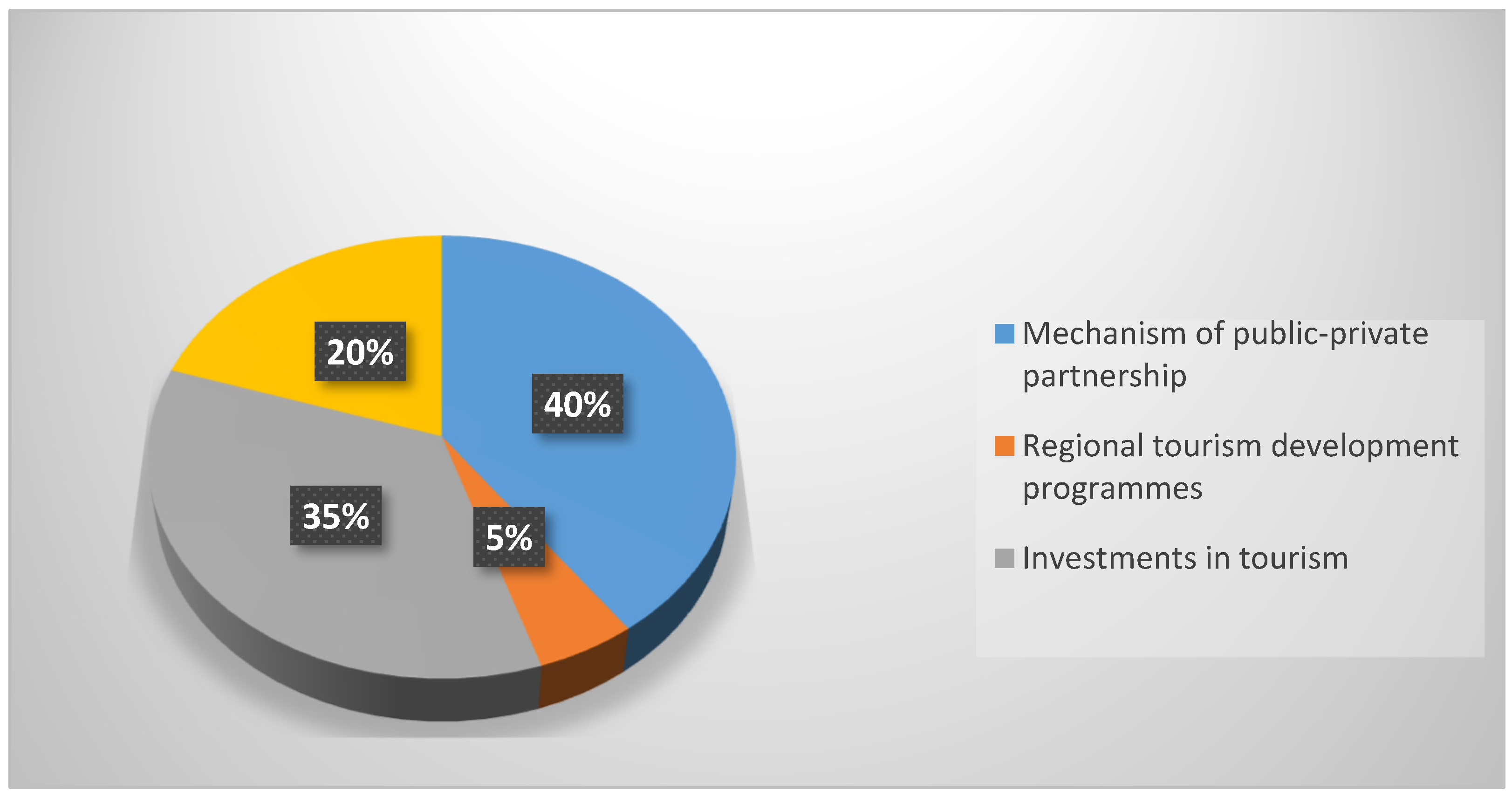
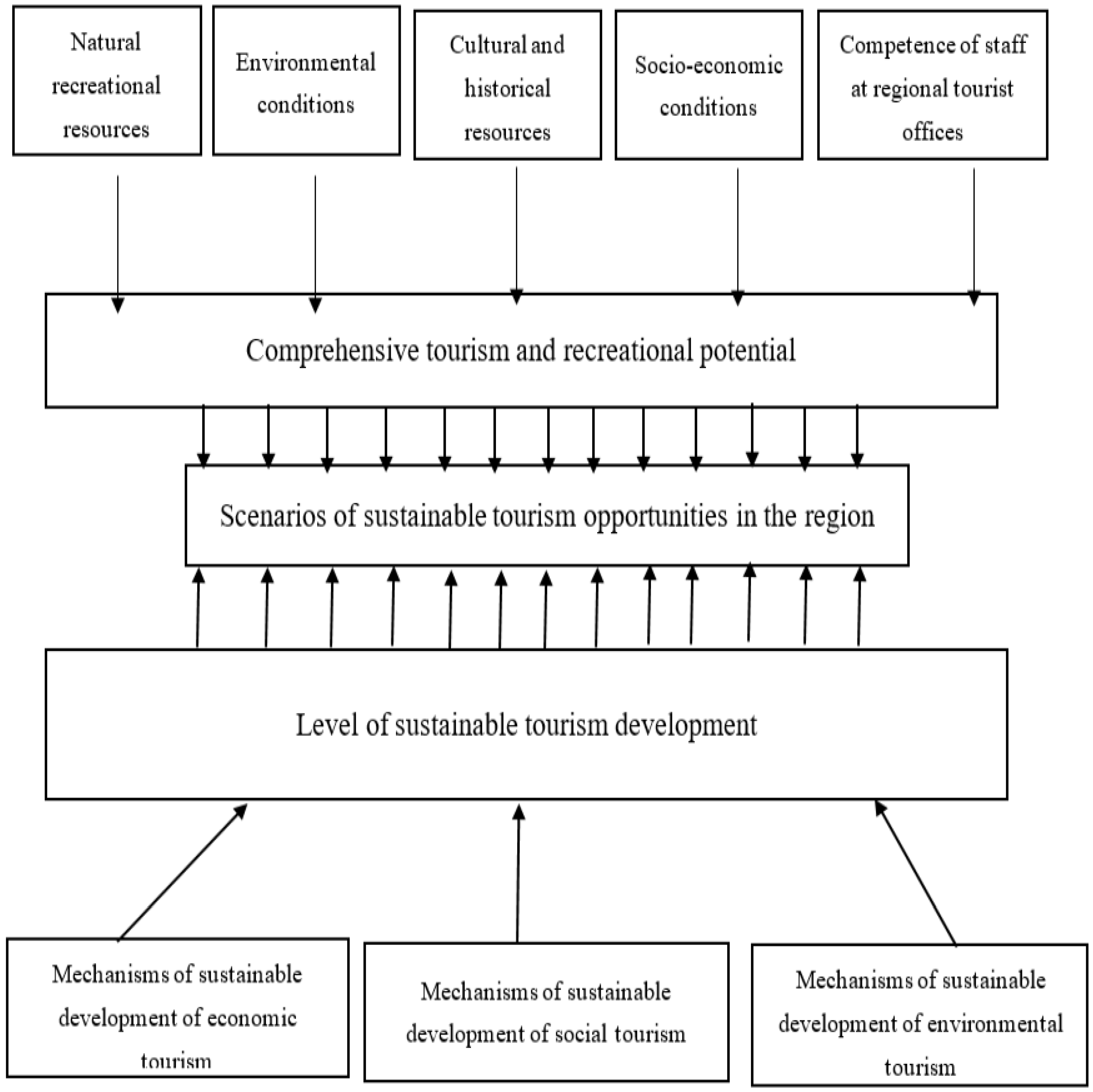
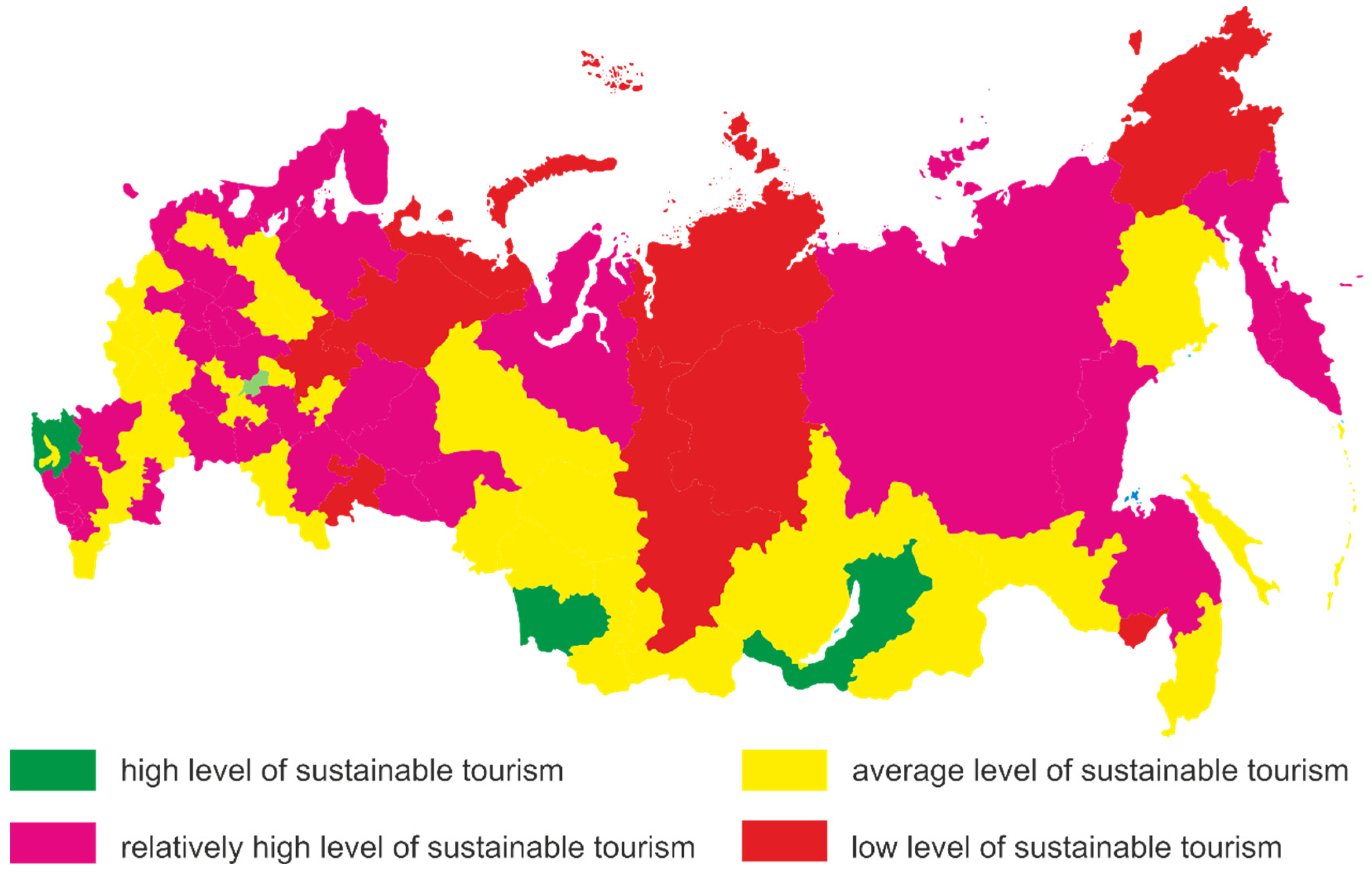
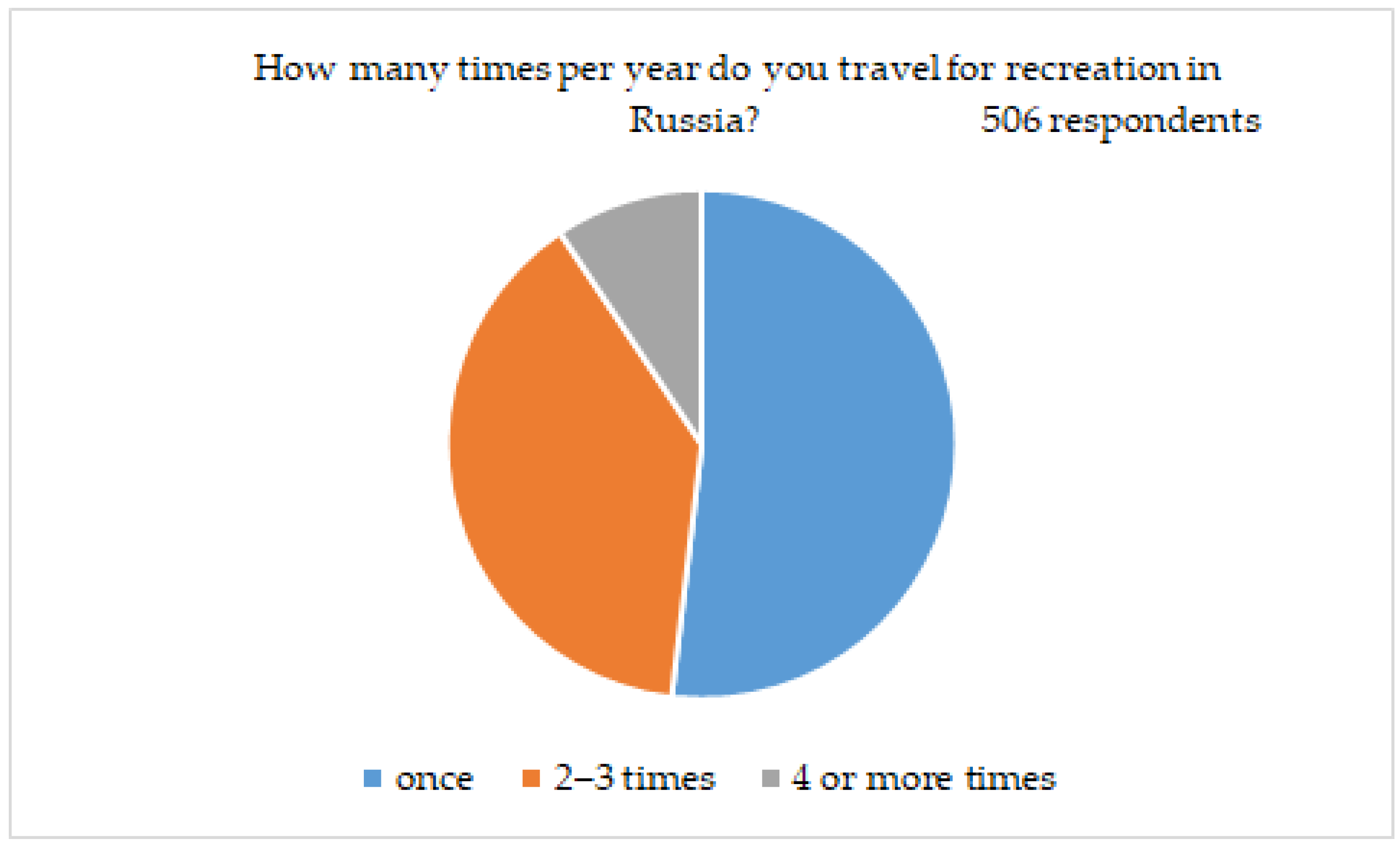
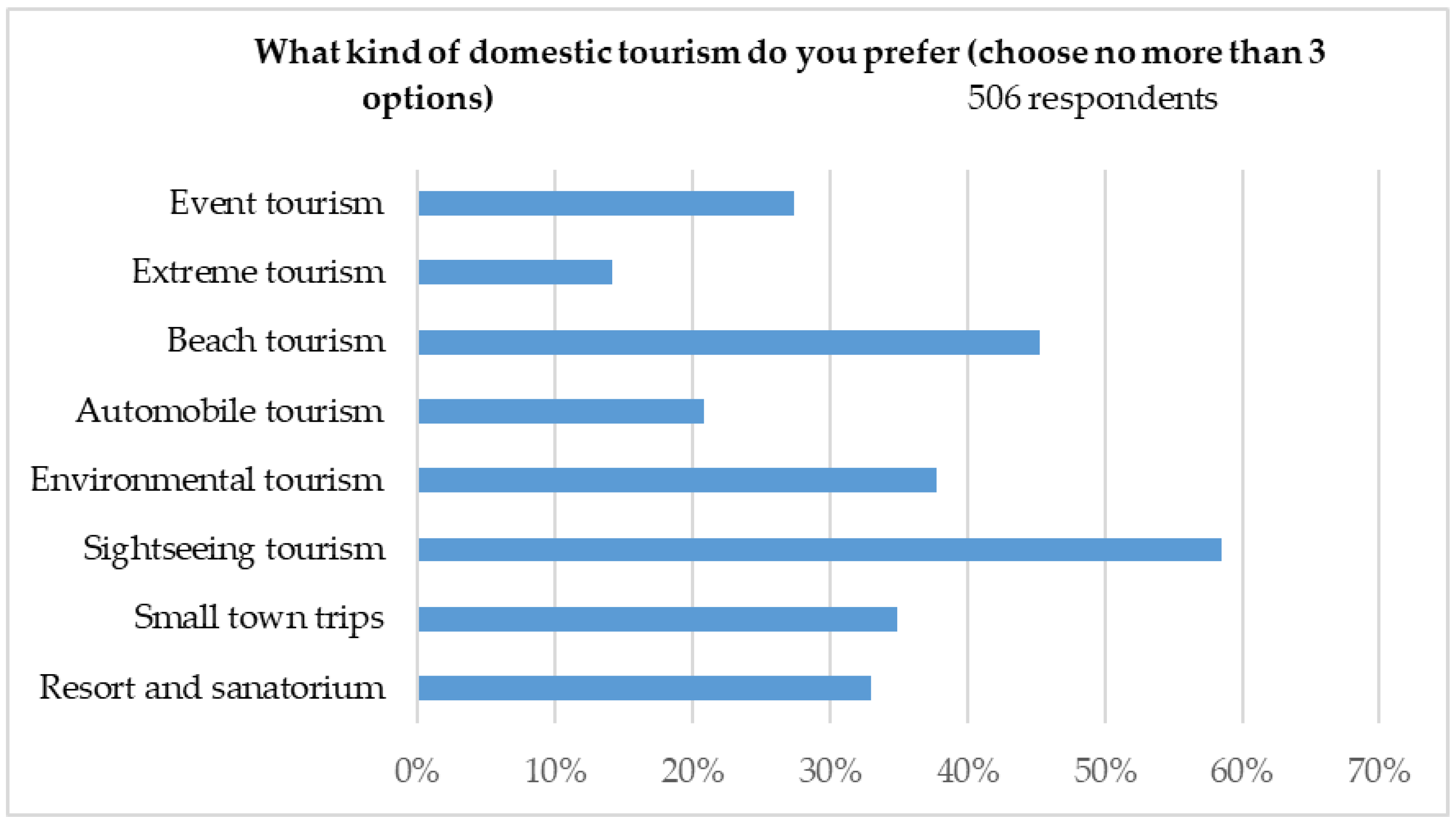
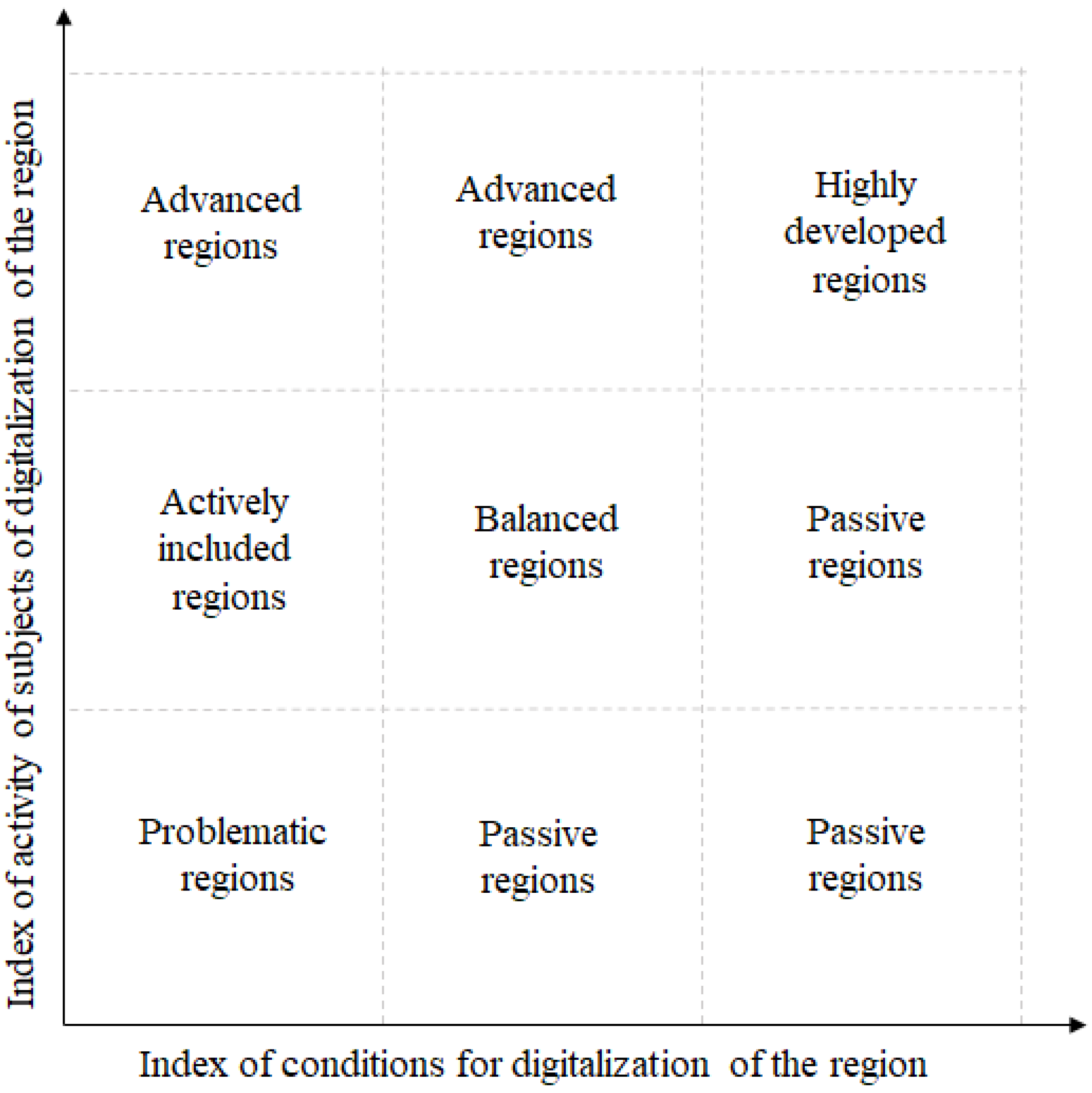
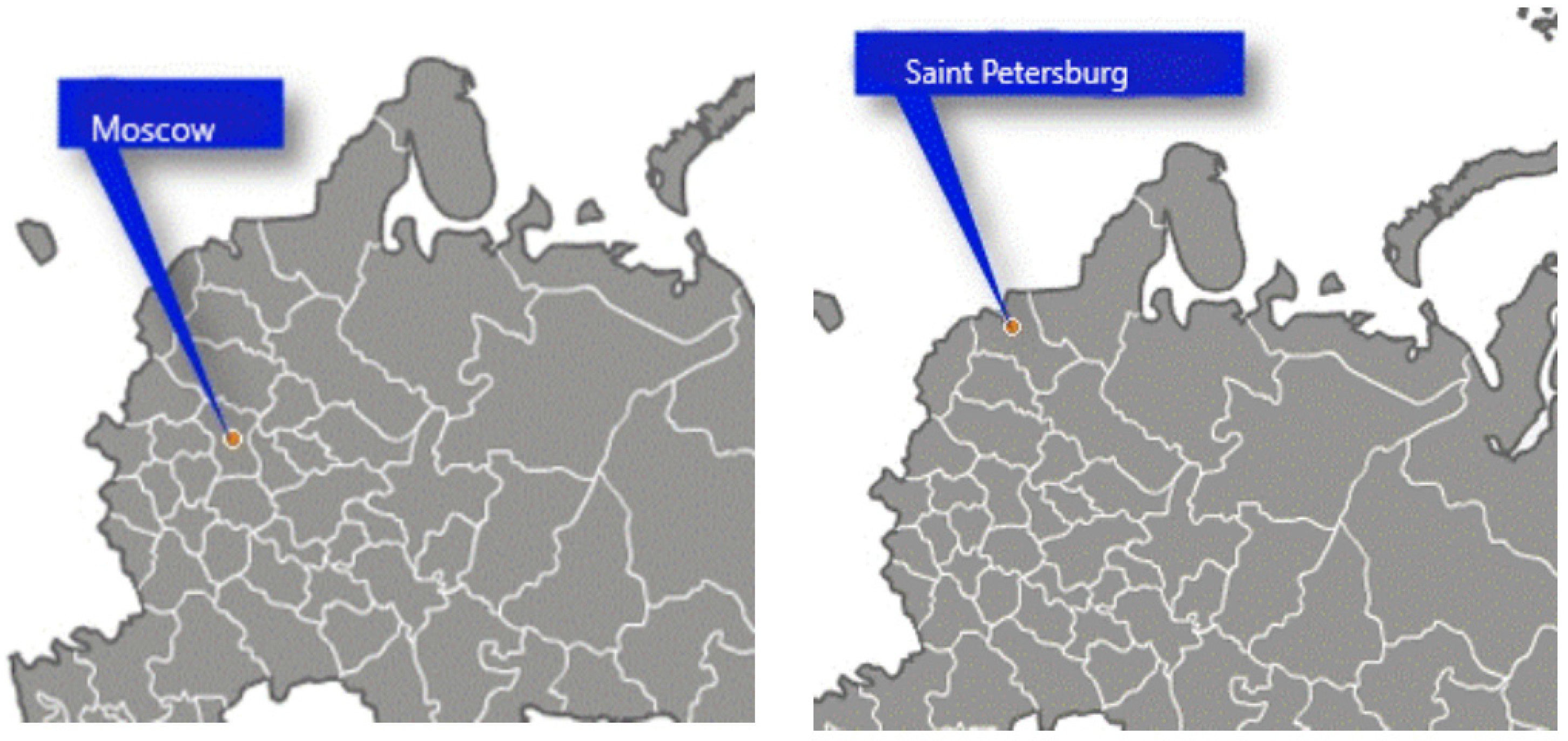
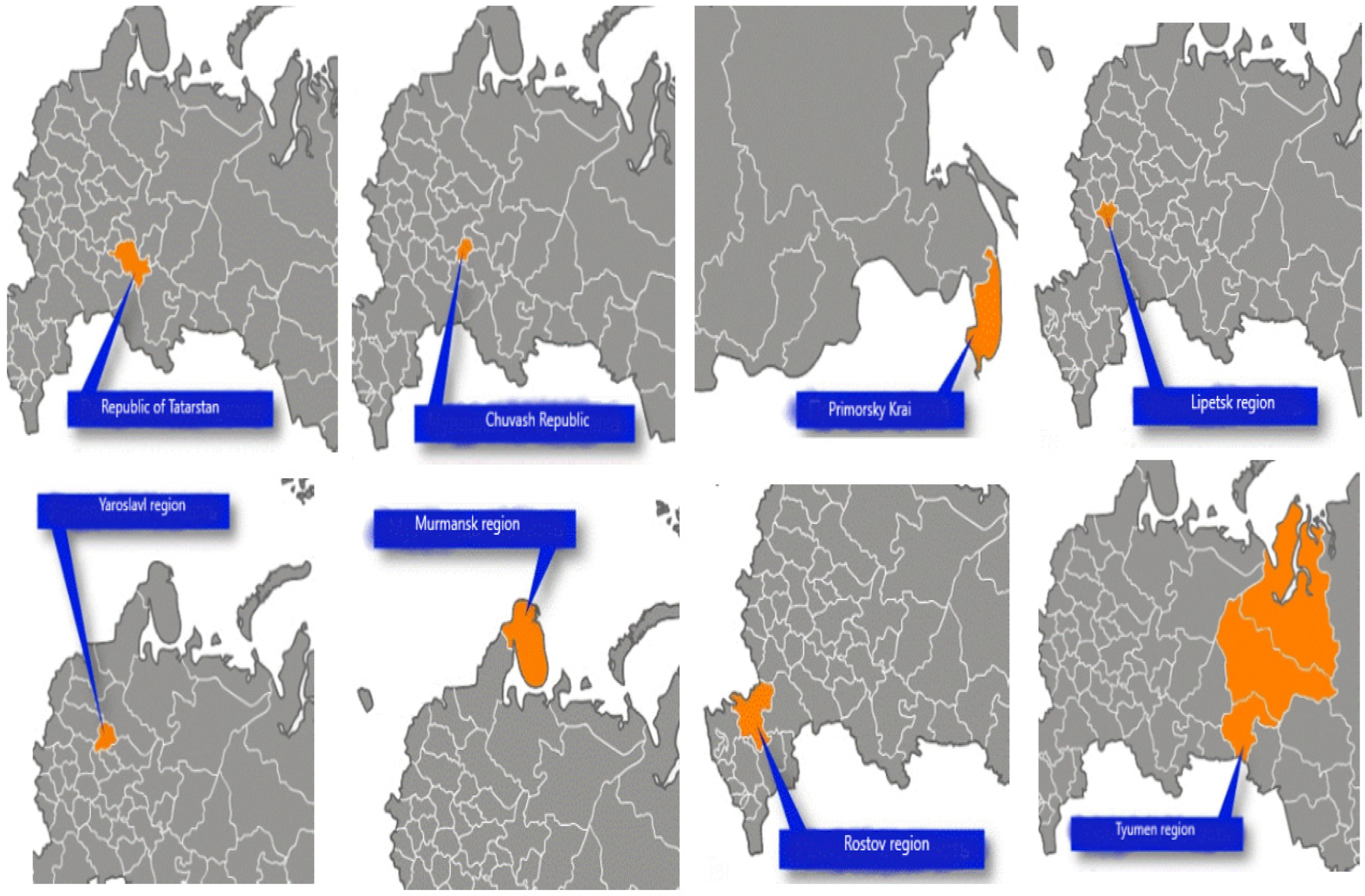

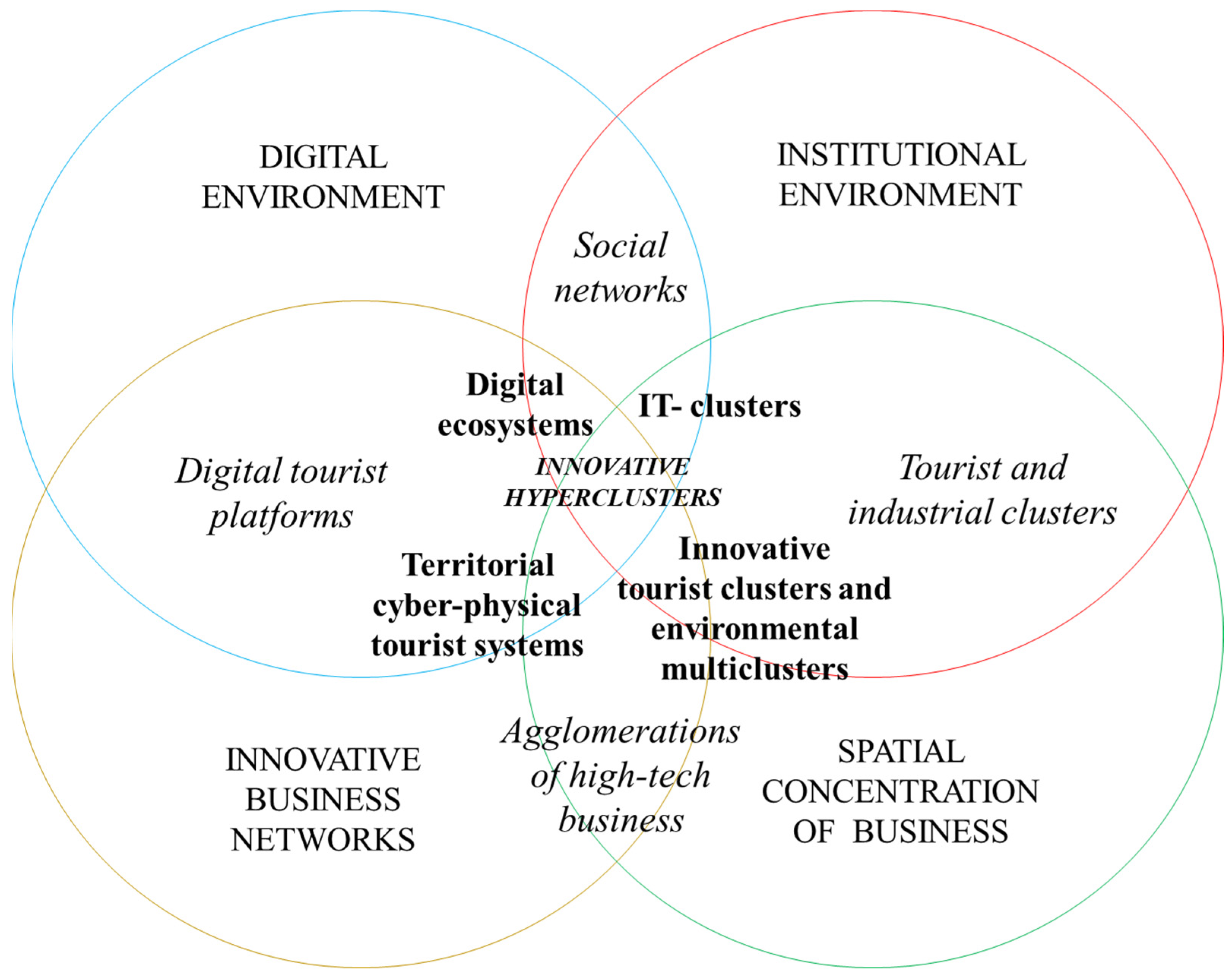
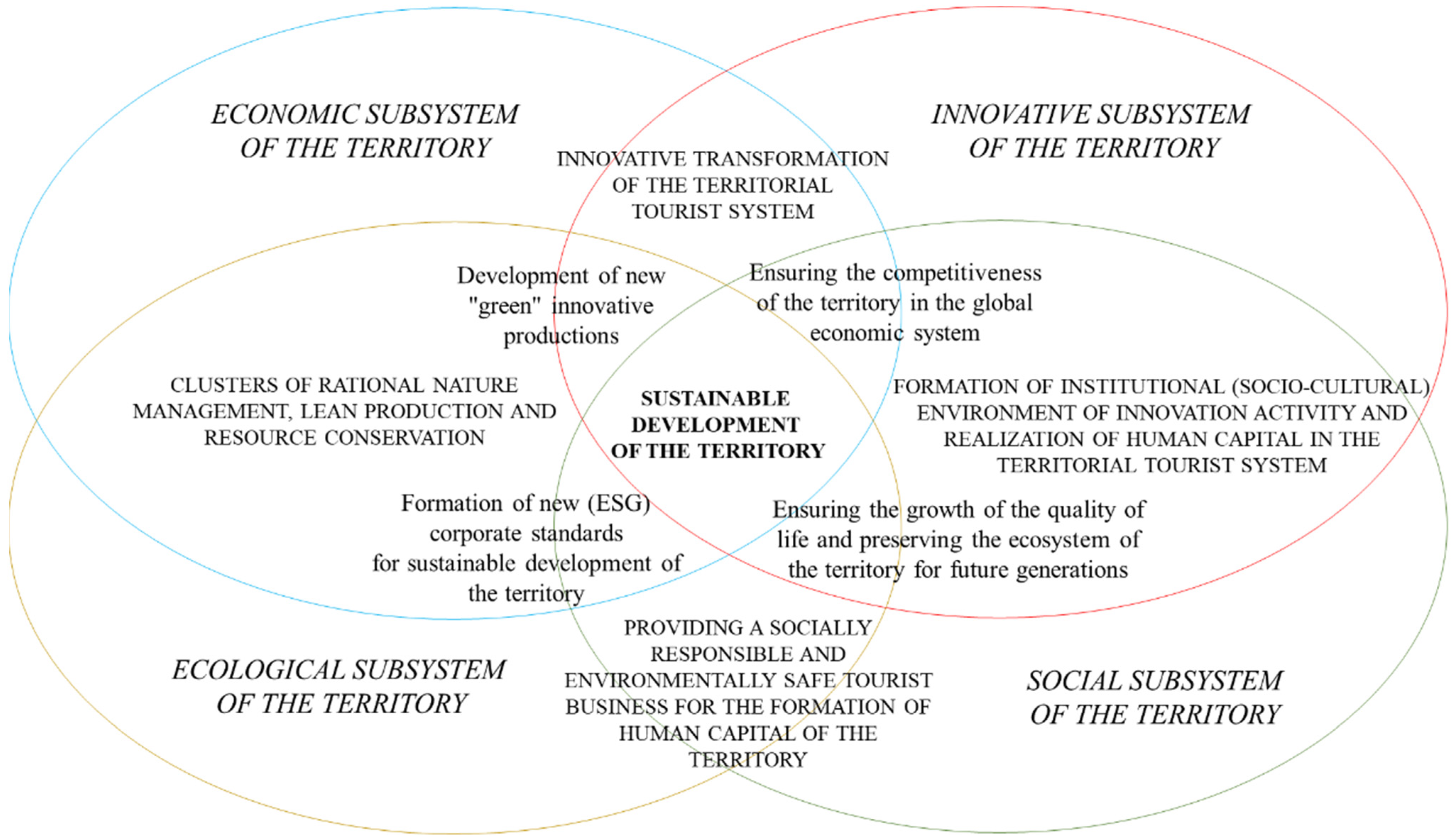
| Form of Digital Economic Interaction | Nature of Economic Interactions | Key Economic Effects | Nature of Competition |
|---|---|---|---|
| Interaction on the Internet | Combination of market competition and cooperation of economic entities | Effects of scale and diversification | Market (monopolistic) competition of individual entities |
| Transactional digital platform | Multilateral interaction of economic entities on the platform | Indirect external effects | Competition between digital platforms |
| Production digital platform | Multilateral interaction of economic entities on the platform | Cross-network effects | Competition within the platform between the participants, between digital platforms |
| Digital ecosystem | Multi-object and omnichannel interaction environment integrating digital platforms and cluster participants | Cross network effects, diversity effects, feedback effects | Competition within an ecosystem, between ecosystems, between clusters integrated within an ecosystem |
| No | Type | Weight of a Type of a Mechanism, % | Mechanism | Weight of a Mechanism |
|---|---|---|---|---|
| 1.1 | Economic | 50 | Mechanism of public–private partnership | 40% |
| 1.2 | Regional tourism development programmes | 5% | ||
| 1.3 | Preferences for small, medium, and large businesses | 20% | ||
| 1.4 | Investment in tourism | 25% | ||
| 1.5 | Marketing of tourism (event calendar, tourist and information centres, participation in national and international exhibitions) | 10% | ||
| 2.1 | Social | 30 | Mechanism of providing access to tourist services in the region | 20% |
| 2.2 | Staffing of the tourism industry | 20% | ||
| 2.3 | Security mechanism | 20% | ||
| 2.4 | Mechanism of tourist accommodation | 20% | ||
| 2.5 | Mechanism of involving local population to work for tourism and recreation sector | 20% | ||
| 3.1 | Environmental | 20 | Determination and rationing of permissible anthropogenic impact | 20% |
| 3.2 | Mechanism of ensuring environmental quality by establishing of a system of protected areas | 20% | ||
| 3.3 | Environmental regulation mechanism (Environmental Index) | 20% | ||
| 3.4 | Mechanism of industrial and environmental regulation (Industrial and Environmental Index) | 20% | ||
| 3.5 | Mechanism of socio-ecological regulation (Socio-Ecological index) | 20% |
| Ranking of Regions of the Russian Federation Depending on the Level of Sustainble Tourism Development | Leader Regions | Regions with High Potential | Regions with Average Potential | Regions with Low Potential |
|---|---|---|---|---|
| High level | 1 | 1 | 2 | 3 |
| Relatively high level | 1 | 2 | 3 | 4 |
| Average level | 2 | 3 | 4 | 5 |
| Low level | 3 | 4 | 5 | 5 |
| Regions Extremely Favourable for Tourism Development (First Group) | Regions Quite Favourable for Tourism Development (Second Group) | Regional Relatively Favourable for Tourism Development (Third Group) | Regions with Low Potential for Tourism Development (Fourth Group) | Regions with Extremely Low Potential for Tourism Development (Fifth Group) |
|---|---|---|---|---|
| The Republics of Buryatia, Krasnodar Territory, Altai Territory, Moscow, St. Petersburg | Yaroslavl Region, Republic of Tatarstan, Kaluga Region, Altai Republic, Leningrad, Moscow, Lipetsk, Sverdlovsk, Kaliningrad Regions, Perm Territory, Khanty-Mansi Autonomous District–Yugra, Rostov, Tyumen, Samara, Irkutsk Region | Vologda Oblast, Tula Oblast, Nizhny Novgorod Oblast, Novgorod Oblast, Republic of Crimea, Astrakhan Oblast, Republic of Karelia, Khanty-Mansi Autonomous District, Primorsky Territory, Tver Oblast, Stavropol Territory, Vladimir Oblast, Saratov Oblast, Voronezh Oblast, Ivanovo Oblast | Chuvash Republic, Republic of Udmurtia, Republic of Mari El, Orel Region, Republic of Kalmykia, Republic of Khakassia, Republic of Adygea, Smolensk Region, Republic of North Ossetia, Murmansk Region, Kursk Region, Orenburg Region | Magadan Region, Krasnoyarsk Territory, Komi Republic, Jewish Autonomous Region, Kirov Region, Nenets and Chukotka Autonomous Districts |
Disclaimer/Publisher’s Note: The statements, opinions and data contained in all publications are solely those of the individual author(s) and contributor(s) and not of MDPI and/or the editor(s). MDPI and/or the editor(s) disclaim responsibility for any injury to people or property resulting from any ideas, methods, instructions or products referred to in the content. |
© 2024 by the authors. Licensee MDPI, Basel, Switzerland. This article is an open access article distributed under the terms and conditions of the Creative Commons Attribution (CC BY) license (https://creativecommons.org/licenses/by/4.0/).
Share and Cite
Polukhina, A.; Sheresheva, M.; Napolskikh, D.; Lezhnin, V. Regional Tourism Ecosystem as a Tool for Sustainable Development during the Economic Crisis. Sustainability 2024, 16, 884. https://doi.org/10.3390/su16020884
Polukhina A, Sheresheva M, Napolskikh D, Lezhnin V. Regional Tourism Ecosystem as a Tool for Sustainable Development during the Economic Crisis. Sustainability. 2024; 16(2):884. https://doi.org/10.3390/su16020884
Chicago/Turabian StylePolukhina, Anna, Marina Sheresheva, Dmitry Napolskikh, and Vladimir Lezhnin. 2024. "Regional Tourism Ecosystem as a Tool for Sustainable Development during the Economic Crisis" Sustainability 16, no. 2: 884. https://doi.org/10.3390/su16020884
APA StylePolukhina, A., Sheresheva, M., Napolskikh, D., & Lezhnin, V. (2024). Regional Tourism Ecosystem as a Tool for Sustainable Development during the Economic Crisis. Sustainability, 16(2), 884. https://doi.org/10.3390/su16020884









